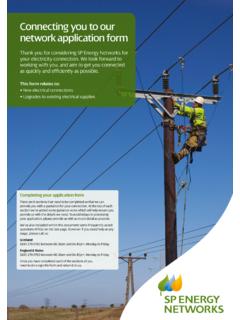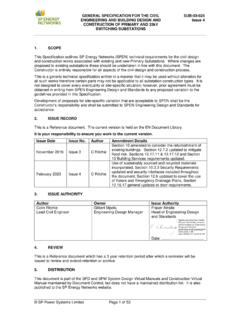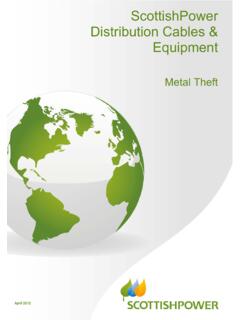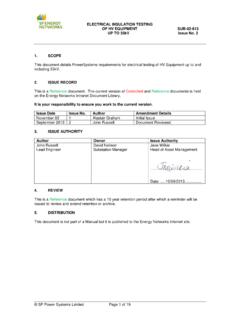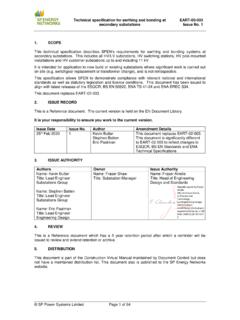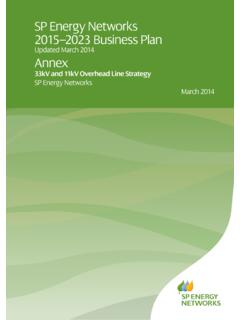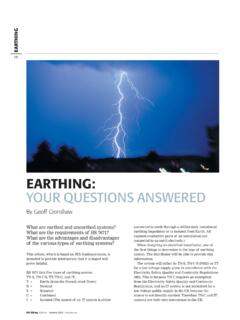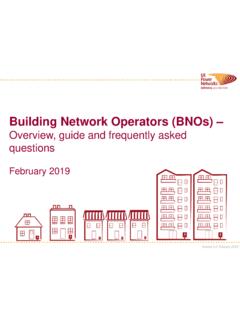Transcription of Safety Requirements for Work On or Adjacent to the ...
1 0 Safety Requirements for Work On or Adjacent to the Distribution & Transmission NetworkHSE-12-011 Nov 2016 1 Foreword This booklet demonstrates SP Energy Networks commitment to protect your health and Safety at work. The Health and Safety at Work Act 1974, indicates It shall be the duty of every employer to ensure, as far as is practicable, the health, Safety and welfare at work of all their employees . Within the UK there are a number of regulations that support the Health and Safety at Work Act 1974, these are compulsory and apply in all situations to which the original Act applies. The two key regulations in this case are The electricity at Work regulations 1989 and the electricity Safety quality and continuity regulations 2002. Please Note :- This booklet is not a substitute for any regulations , Codes of Practice, or Health and Safety Policies. You play an important role When it comes to establishing and maintaining a safe working environment.
2 By law, working safely is one of your responsibilities. The Health and Safety at Work Act 1974, indicates It shall be the duty of every employee while at work to take reasonable care of the health and Safety of themselves and other persons who may be affected by their acts or omissions at work SP Energy Networks, its contractors and your co-workers are counting on you to: Follow all Safety rules that relate to your duties and responsibilities. Work within the limits of the Authorisation`s issued Minimise the risk of injury to yourself and others. Minimise the risk of damage to property. Use protective clothing and Safety equipment. Co-operate with your employer and any other person to ensure health and Safety obligations are met. 2 Index Forward General Information Authorisation Categories Demarcation o Substations o Tower Working o Excavations o Wood Pole Signage o SP Energy Networks o Safety Signs & Signals o Signing and Guarding Isolation Earthing - Primary/Drain/Fixed Drain/Field Equipment Safety Documents Safety Distances Responsibilities Safety Rule Structure Risk Assessment Trade Specific o Substations o Towers & Wood Poles Lightning Risk Warning o Tree Cutting o Excavations & Underground Cable o HV Cable Identification Tools and Test Equipment Interview Preparation Guide Emergency Arrangements Safety Checklist For Further Testing Procedures Refer to Metered & Unmetered Supplies Booklet HSE-12-005 6 14 16 19 21 22 23 26 27 27 30 34 36 37 46 47 This document shall be reviewed as dictated by business change or at a period no longer than 5 years from date of issue 5 3 3 General Information What is Insulation?
3 Insulation can be formed from a range of material s such as: Paper, plastic, rubber, neoprene shrouding, porcelain, glass, insulating Oil or SF6 gas (sulphur hexafluoride) and vacuum. These materials and substances form a barrier between the live conductors and earthed metalwork to ensure separation is maintained. They can also protect operatives from making contact with live components which could result in electric shock fire or explosion. What are Protection Devices? Protection Devices can be - Circuit Breakers, Auto-reclosers, Smart Links and Fuses both LV and HV. When any of these devices are tripped or operated they create a sufficient gap between the Live source and the part of the system being protected. What is Restriction of Access? Demarcation within Scottish Power Substation (PSSI 6) is one method of restricting access and controlling the safe work area (see page 6 and 7). Defining the limits of a work area with Danger Live apparatus notices is another method of restricting access.
4 4 Establishing a physical barrier between live components and the safe area of work will ensure safe performance of the work. Clear and unambiguous communication is crucial to establishing the above. Access can also be restricted by use of road barriers around excavations, securing or locking off cabinets or specific switches, use of castell key arrangements, anti vandal and anti climbing devices. What is an Electrical Short Circuit? An Electrical Short Circuit can be caused by two electrical Live conductors making contact with each other, or a Live conductor making contact with earthed metalwork resulting in a release of fault energy, flash over or explosion. What is a Competent Person? A Competent Person is a person with the relevant training, knowledge & experience to carry out their duties safely who are then issued with the appropriate Authorisation levels required by the company policies and procedures. Competency is maintained by attending and successful completing refresher training and the subsequent re-issue of the appropriate Authorisations.
5 When Scottish Power deems an individual to be Competent they will issue a specific level of Authorisation with the appropriate limitations or exclusion applied at the required voltage levels. ScottishPower Safety Rules & Procedures 5 AUTHORISATION CATEGORIES Listed here is a brief description of some of the authorisation categories required for the more common and routine types of operational activity undertaken on and around the SP Network. Authorisation categories may be applied to one, or more, of five voltage levels (LV; 11kV; 33kV; 132kV; 275/400kV) and may also be adapted for operational purposes by applying Limitations or Exclusions to the particular category at the particular voltage level. Refer to MSP (OPSAF-13-001) for further information on Authorisation Procedures including all available Authorisation C ategories, Limitations and Exclusions. Working on or Adjacent to the System WI-1 Allows the holder to work on Isolated Plant and Apparatus including work Adjacent to Live Apparatus WI-2 Allows the holder to do Non-electrical work Adjacent to Live Apparatus WI-3 Allows the holder to work on Isolated Protection/Telecoms/Metering equipment WI-PS Allows the holder to work under Personal Supervision only to the limit of accompanying Persons "WI" authorisation (primarily for the purpose of training)
6 WL-1 Allows the holder to work on, or near to, Live Apparatus as specified on the accompanying Live Work Certificate WL-2 Allows the holder to work as the Accompanying Person for work on, or near to, Live Apparatus WL-PS Allows the holder to work under Personal Supervision only to the limit of accompanying Persons "WL" authorisation for training purposes Substation Access AME-SS or EN-1/2 Allows the holder independent entry to Substations with exposed Live Bus Bars and is the equivalent to EN-1 and WI-2 Standby SB-1 Allows the holder to Standby Personnel & Work/Access Equipment in accordance with PSSI-6 & 8 SB-2 Allows the holder to Standby Personnel & Work at ground level excluding long objects Drain Earth Application DE-1 Allows the holder to apply and remove Drain Earth following testing DE-PS Allows the holder under Personal Supervision to apply Drain Earth (Training Purposes) Switching OP-1 Switching (Without Limitation or Exclusion within Voltage Level) OP-2 Switching (With Limitations) OP-3 Insert & Remove LV Cut-out fuses Safety Documents Issue & Receive SI-1 Allows the holder, a Senior Authorised Person (SAP), to prepare, issue, receive, clear and cancel all Safety Documents, without Limitation or Exclusion within Voltage Level SI-2 Allows the holder, a Senior Authorised Person (SAP), to prepare, issue and cancel, PFW, SFT, LWC SI-3 Allows the holder, a Senior Authorised Person (SAP), to prepare, issue and cancel PFW, LWC SR-3 Allows the holder receive and clear PFW, LWC SR-4 Allows the holder to receive and clear LWC PFW = Permit for Work - LWC = Limited Work Certificate - SFT = Sanction for Test 6 Demarcation Open Bus Bar Substations Equipment used to designate a safe work area and access route within a Substation.
7 Safe Working Area - Red Cones (up to 7m apart), two orange ropes (10mm) used on each side of the yellow angled cross arm and Green Cones (up to 6m apart), define the safe working area within the roped perimeter. Only Authorised work may be conducted in these areas, with the approval of the Safety document holder. The higher side of the cross arm defines the safe side. Cones should be weighted with loose gravel for stability where appropriate. Access Route to Safe Working Area - Red Cones (up to 10m apart), used to define the access route, only one orange rope (10mm) on the high side of the yellow cross arm.. Further procedures/information are contained in the ScottishPower Safety Rule, PSSI 6 Access Route 7 Defined Safe Work Area Various markers and signs define which areas are safe to work in and which are not. Here are some items to look for: Two Orange ropes on Yellow angled crossarms, mounted on Red Cones This along with the Green Cones designates a safe work area and is established by the SAP prior to the issue of the Permit for Work.
8 Authorised work may be conducted in these areas-only with the approval of the Safety Document holder. Green cones These are placed within the safe work area. They indicate that the demarcated area is safe. Danger Notices These are wrapped around or fixed to Adjacent Live structures, which are positioned outside the safe work areas, to warn you it is unsafe. 8 Transmission OHL`s Tower Identification is determined by a number plate fitted Adjacent to the property plate, which is fitted just above the anti-climb device. This number provides a unique identification of every transmission tower. Most towers carry more than one circuit, so each circuit has to be positively identified. Circuit Identification Colour Plates are located on each side of the tower, attached to the climbing leg above the anti-climb device. Each circuit will be identified by a different colour. There may be additional colour plates on the tower at each cross arm. Green, Circuit Identification Flags are used as part of the identification for the circuit being worked on, which has been Isolated and Earthed.
9 The Flag-staff is colour coded to match the colour plates on the tower, the Flag-staff is also keyed to fit into a unique shaped bracket, mounted on the climbing leg of the tower, this matches the shape of the flag fitting. Note:- where no bracket is fitted or the flag does not fit, access to the tower shall cease. D H 101 A 400,000 VOLTS 0141-776 2877 9 Wristlets are coloured to match the circuit identification flag-staff and the circuit identification plate on the leg of the tower. These wristlets are worn by all personnel working on the tower. Red pennants are positioned to identify the limit of your safe work area you must not pass them. Live Tower Identification Plate Circuit Identification Colour Plates 10 The Red Pennants are installed within the tower on the Live circuit(s) at the junction of the cross-arm and body of the tower (example of a double circuit tower) Within PSSI 4 there is instruction on the demarcation arrangement and controls to be established prior to work commencing, it also provides a range of earthing schemes (contained in Attachment A Section 5) associated with certain types of work for example: Example :- Scheme 1B Painting and Inspection of Towers This describes the Requirements for application of Drain Earths to carry out this type of work.
10 Drain earths shall be applied not more than 10 span apart and will be positioned each side of the point of work. Access will be within the Safety distance but no closer than 1 metre. 11 Exclusion, Danger or Hazard Zone Establishing and controlling an exclusion zone around the base of any structure being worked on, will prevent staff or third parties from injury due to falling objects, this is also considered demarcation. The demarcated area shall be physically controlled (minimum of continuous rope, chain or tape). All items being moved to and from the work position on the structure above the exclusion zone including lifting equipment shall be securely attached prior to movement. No entry to be permitted into the demarcated area without permission and verbal confirmation from the nominated person that all works and movement above have stopped Road Works Installation and maintenance of the road and street works barrier including signage are a crucial part of the demarcation arrangements to protect yourself 12 and members of the public while working on the public footpath.

